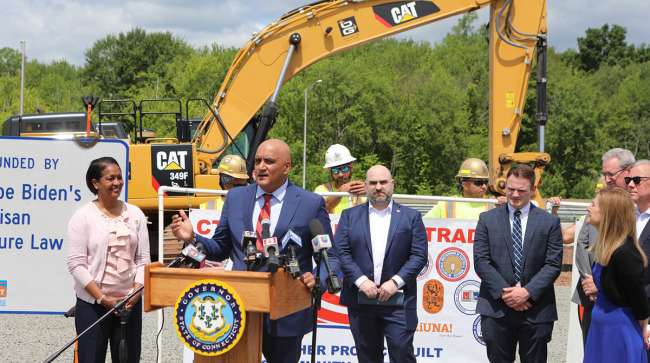Staff Reporter
Conn. Project to Revamp Congested Interchange Gains Traction

[Stay on top of transportation news: Get TTNews in your inbox.]
The second phase of a $500 million reconfiguration of interstates 91 and 691 in Connecticut commenced on a congested freight route two hours from Boston and New York.
“Reconfiguring this highway to improve safety and traffic flow is directly connected with our ability to encourage businesses to locate, expand and grow jobs in the region because it serves as a critical link for passengers and freight connecting critical corridors between New York and Massachusetts,” Connecticut Gov. Ned Lamont said recently.
He thanked the Biden administration, the Federal Highway Administration, Connecticut’s congressional delegation and state legislators for their support and providing the funding “to get shovels in the ground and make this much-needed project a reality.”
Government officials gathered in Meriden, where the busy interchange connects I-91, I-691 and Connecticut Route 15. The location between Hartford and New Haven is about two hours between New York and Boston, which make it a central point for trucking East Coast freight. Lamont referred to the interchange as consistently among the most congested and dangerous highway sections in the state.
Today, the BILT team was proud to attend the groundbreaking ceremonies for the reconfiguration of the highway interchange connecting I-91, I-691, and Route 15 in Meriden. Learn more about the project from @CTDOTOfficial: https://t.co/z6XmTgvijJ pic.twitter.com/wIpQRLNSXE — CTBILT (@ctbilt) June 11, 2024
FHWA Administrator Shailen Bhatt expressed the federal government’s commitment “to getting things done for the American people, creating opportunities that improve safety and quality of life and making sure federal dollars are helping to modernize our transportation infrastructure all over the country.”
All three highways converge in a complex system consisting of through lanes, weaving road sections and ramp connections at the I-91/I-691/Route 15 interchange, which provides a critical freight route in the Northeast regional transportation network. It also connects the I-84 and I-91 corridors between the state and southern New York to northern Massachusetts and beyond.
According to the Connecticut Statewide Freight Plan Update in December 2022, I-95 (from the New York/Connecticut border to New Haven and between New Haven/Hartford) carries the largest truck volumes.
The project calls for adding bridges and culverts, building/rehabilitating culverts, widening traffic lanes, upgrading barriers/guardrails, improving highway lighting, replacing existing signs, repaving all three thoroughfares and mitigating noise. Not only will the reconfiguration improve traffic flows, it also is meant to reduce crashes to increase safer, more efficient travel.
“We’re going to fix the interchange to reduce congestion and improve safety for generations,” noted state Transportation Commissioner Garrett Eucalitto, adding that the spot is a “painstaking” bottleneck for Connecticut travelers.
Second Phase
What will the second stage of the interchange upgrade entail?
- Adding a new two-lane exit ramp from Route 15 northbound to I-91 northbound to reduce traffic congestion on the Exit 68 north-east ramp.
- Closing the existing Exit 17 ramp from I-91 northbound to Route 15 northbound and rerouting traffic to Exit 16 to provide a two-lane exit ramp with a right-side traffic merge onto Route 15 northbound.
- Widening the existing Exit 68 west ramp from Route 15 northbound to I-691 westbound to two lanes.
- Reconfiguring acceleration and deceleration lanes to provide adequate traffic weaving distances.
Connecticut is paying the full $80 million price tag for the first construction phase, which started in October and is expected to be completed within a year. Projected to be finished by November 2028, the second phase is supported by $50 million in state funding and $200 million in federal funding from the bipartisan infrastructure law.
The final $170 million phase, anticipated to start next year, is expected to be funded by state and federal dollars. It will lower congestion by adding a two-lane exit ramp from Route 15 southbound to I-91 southbound on the Exit 67 ramp, and by creating a two-lane I-91 southbound ramp to Route 15 southbound on the Exit 17 ramp. Ramps will also be widened to two lanes from I-691 eastbound to Route 15 southbound (Exit 10) and by two lanes from I-91 southbound to I-691 westbound (Exit 18).
To reconfigure the outdated highway corridor, the Connecticut Department of Transportation is eliminating dangerous points, correcting roadway geometry and adding multilane exits. Upon completion in 2030, the area will have more and better bridges plus extra travel lanes to improve traffic flows.
Want more news? Listen to today's daily briefing below or go here for more info:




